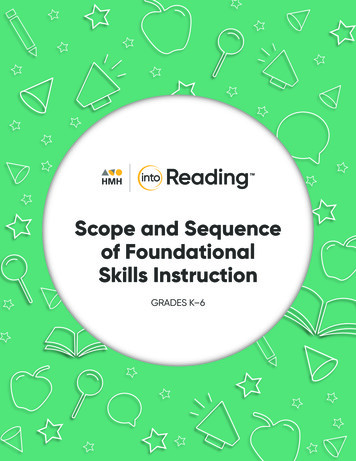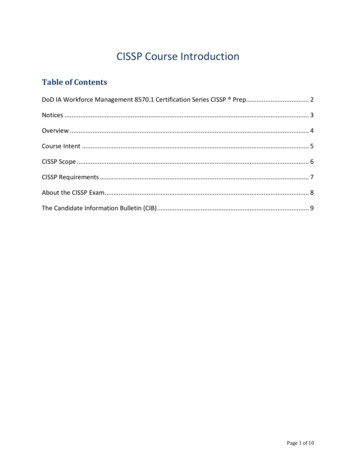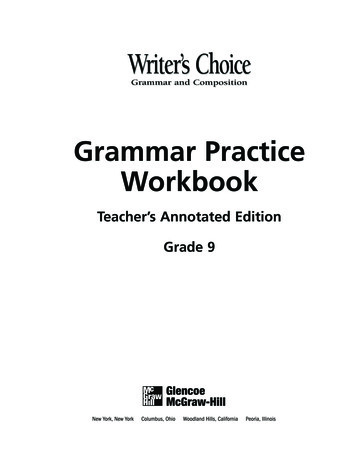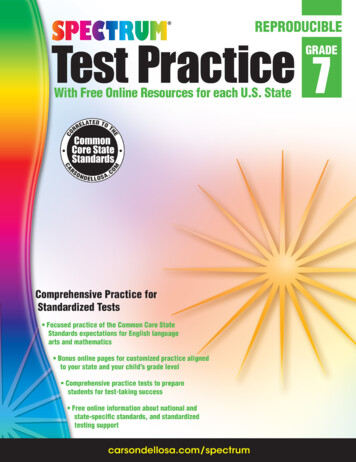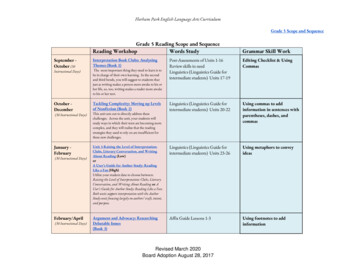
Transcription
Florham Park English Language Arts CurriculumGrade 5 Scope and SequenceGrade 5 Reading Scope and SequenceReading WorkshopWords StudySeptember October (30Grammar Skill WorkInterpretation Book Clubs: AnalyzingThemes (Book 1)The most important thing they need to learn is tobe in charge of their own learning. In the secondand third bends, you will suggest to students thatjust as writing makes a person more awake to his orher life, so, too, writing makes a reader more awaketo his or her text.Editing Checklist & UsingCommasInstructional Days)Post-Assessments of Units 1-16Review skills in needLinguistics (Linguistics Guide forintermediate students) Units 17-19October DecemberTackling Complexity: Moving up Levelsof Nonfiction (Book 2)(30 Instructional Days)This unit sets out to directly address thesechallenges. Across the unit, your students willstudy ways in which their texts are becoming morecomplex, and they will realize that the readingstrategies they used to rely on are insufficient forthese new challenges.Linguistics (Linguistics Guide forintermediate students) Units 20-22Using commas to addinformation in sentences withparentheses, dashes, andcommasJanuary FebruaryUnit 3-Raising the Level of Interpretation:Clubs, Literary Conversation, and WritingAbout Reading (Low)orA User’s Guide for Author Study: ReadingLike a Fan (High)Utilize your student data to choose between:Raising the Level of Interpretation: Clubs, LiteraryConversation, and Writing About Reading or AUser’s Guide for Author Study: Reading Like a Fan.Both units support interpretation with the AuthorStudy unit focusing largely on authors’ craft, intent,and purpose.Linguistics (Linguistics Guide forintermediate students) Units 23-26Using metaphors to conveyideasArgument and Advocacy: ResearchingDebatable Issues(Book 3)Affix Guide Lessons 1-3Using footnotes to addinformation(30 Instructional Days)February/April(30 Instructional Days)Revised March 2020Board Adoption August 28, 2017
Florham Park English Language Arts CurriculumGrade 5 Scope and SequenceThe unit aims to help them think for themselvesand learn to have an informed viewpoint and tocommunicate it clearly, as well as to listen to others.It aims to help them think about complicatedissues, which the world is dealing, and to makedecisions that will let them live more informed lives.*3 Week Test Prep Unit*May - June(30 Instructional Days)Fantasy Book Clubs: The Magic ofThemes and Symbols (Book 4)OptionalAdditional UnitsReading in the Content Areas(Curricular Calendars)This unit aims to capture students passion forfantasy reading as a means of increasing their facilitywith complex texts and interpretation.Linguistics Post-assessmentReinforce Areas in need based on postassessment resultsThis unit focuses on reading to learn as studentsread about science or social studies topics related totheir current curriculum. The emphasis in this unitthen is on reading to gain knowledge and constructideas.Revised March 2020Board Adoption August 28, 2017Varying punctuation formood & toneColons and dividing longsentences
Florham Park English Language Arts CurriculumGrade 5 Scope and SequenceReading WorkshopUnit 1: Interpretation Book Clubs: Analyzing Themes (Book 1)Unit DescriptionGrade: 5This unit asks a lot of students and gives a lot to them as well. The learning curve between fourth and fifth grade is an especially steep one, and work that fifth-graders areasked to do is work that many of us didn’t do until high school (if then!). The fact that students will convene in clubs within a week or two of the start of fifth grade isemblematic of the tone and the message that characterize this unit. You’ll set students up to participate by telling them that the most important thing they need to learn is tobe in charge of their own learning. In the second and third bends, you will suggest to students that just as writing makes a person more awake to his or her life, so, too,writing makes a reader more awake to his or her text. Readers who write can see more in a text- the notice more and they make more of what they see. This bend quicklyturns to the work of interpretation, teaching students how to read with interpretive lenses. Finally, you will teach students to read analytically, noticing the way differentauthors develop the same theme differently. You’ll also help them do some important compare-and-contrast work on several texts that develop a similar theme, too.Big Ideas: Course Objectives / Content Statement(s) Study characters to synthesize, infer, and interpret information Create effective book clubs to elevate levels of reading, thinking and conversations Read at level books to develop the skills to write well about readingNJ Student Learning StandardsWriting StandardsW.5.1 Write opinion pieces on topics or texts, supporting a point of view with reasons and information.W.5.2 Write informative/explanatory texts to examine a topic and convey ideas and information clearly.W.5.3 Write narratives to develop real or imagined experiences or events using effective technique, descriptive details, and clear event sequences.W.5.4 Produce clear and coherent writing in which the development and organization are appropriate to task, purpose, and audience.W.5.5 With guidance and support from peers and adults, develop and strengthen writing as needed by planning, revising, editing, rew riting, or trying a new approach.W.5.9 Draw evidence from literary or informational texts to support analysis, reflection, and research.Revised March 2020Board Adoption August 28, 2017
Florham Park English Language Arts CurriculumGrade 5 Scope and SequenceA.Apply grade 5 Reading standards to literature (e.g., “Compare and contrast two or more characters, settings, or events in a story or a drama, drawing on specific details in the text [e.g., howcharacters interact]”).W.5.10 Write routinely over extended time frames (time for research, reflection, metacognition/self-correction and revision) and shorter time frames (a single sitting or a day or two) for a range of discipline-specifictasks, purposes, and audiences.Reading StandardsRF.5.3 Know and apply grade-level phonics and word analysis skills in decoding and encoding words.A. Use combined knowledge of all letter-sound correspondences, syllabication patterns, and morphology (e.g., roots and affixes) to read accurately unfamiliar multisyllabic words in context andout of context.RF.5.4 Read with sufficient accuracy and fluency to support comprehension.A. Read grade-level text with purpose and understanding.B. Read grade-level prose and poetry orally with accuracy, appropriate rate, and expression.C. Use context to confirm or self-correct word recognition and understanding, rereading as necessary.RL.5.1 Quote accurately from a text, and make relevant connections when explaining what the text says explicitly and when drawing inferences from the text.RL.5.2 Determine the key details in a story, drama or poem to identify the theme and to summarize the text.RL.5.3 Compare and contrast two or more characters, settings, or events in a story or drama, drawing on specific details in the text (e.g., how characters interact).RL.5.4 Determine the meaning of words and phrases as they are used in a text, including figurative language such as metaphors and similes.RL.5.5 Explain how a series of chapters, scenes, or stanzas fits together to provide the overall structure of a particular story, drama, or poem.RL.5.6 Describe how a narrator’s or speaker’s point of view influences how events are described.RL.5.7 Analyze how visual and multimedia elements contribute to the meaning, tone, or beauty of a text (e.g., graphic novel, multimedia presentation of fiction, folktale, myth, poem).RL.5.9 Compare, contrast and reflect on (e.g. practical knowledge, historical/cultural context, and background knowledge) the treatment of similar themes and topics (e.g., opposition of good and evil) and patternsof events (e.g., the quest) in stories, myths, and traditional literature from different culturesRL.5.10 By the end of the year, read and comprehend literature, including stories, dramas, and poems at grade level text-complexity or above, with scaffolding as needed.RI.5.2 Determine two or more main ideas of a text and explain how they are supported by key details; summarize the text.RI.5.10 By the end of year, read and comprehend literary nonfiction at grade level text-complexity or above, with scaffolding as needed.Speaking and Listening StandardsSL.5.1 Engage effectively in a range of collaborative discussions (one-on-one, in groups, and teacher-led) with diverse partners on grade 5 topics and texts, building on others’ ideas and expressing their own clearly.A. Explicitly draw on previously read text or material and other information known about the topic to explore ideas under discussion.B. Follow agreed-upon rules for discussions and carry out assigned roles.C. Pose and respond to specific questions by making comments that contribute to the discussion and elaborate on the remarks of others.D. Review the key ideas expressed and draw conclusions in light of information and knowledge gained from the discussions.SL.5.2 Summarize a written text read aloud or information presented in diverse media and formats (e.g.,visually, quantitatively, and orally).SL.5.3 Summarize the points a speaker makes and explain how each claim is supported by reasons and evidence.SL.5.4 Report on a topic or text or present an opinion, sequencing ideas logically and using appropriate facts and relevant, descrip tive details to support main ideas or themes; speak clearly at an understandable pace.SL.5.6 Adapt speech to a variety of contexts and tasks, using formal English when appropriate to task and situation.Language StandardsL.5.1 Demonstrate command of the conventions of standard English grammar and usage when writing or speaking.L.5.2 Demonstrate command of the conventions of standard English capitalization, punctuation, and spelling when writing.L.5.3 Use knowledge of language and its conventions when writing, speaking, reading, or listening.A. Expand, combine, and reduce sentences for meaning, reader/listener interest, and style.L.5.4 Determine or clarify the meaning of unknown and multiple-meaning words and phrases based on grade 5 reading and content, choosing flexibly from a range of strategies.A. Use context (e.g., cause/effect relationships and comparisons in text) as a clue to the meaning of a word or phrase.B. Use common, grade-appropriate Greek and Latin affixes and roots as clues to the meaning of a word (e.g., photograph, photosynthesis).C. Consult reference materials (e.g., dictionaries, glossaries, thesauruses), both print and digital, to find the pronunciation and determine or clarify the precise meaning of key words and phrases.Revised March 2020Board Adoption August 28, 2017
Florham Park English Language Arts CurriculumGrade 5 Scope and SequenceL.5.5 Demonstrate understanding of figurative language, word relationships, and nuances in word meanings.A. Interpret figurative language, including similes and metaphors, in context.B. Recognize and explain the meaning of common idioms, adages, and proverbs.C. Use the relationship between particular words (e.g., synonyms, antonyms, homographs) to better understand each of the words.L.5.6 Acquire and use accurately grade-appropriate general academic and domain-specific words and phrases, including those that signal contrast, addition, and other logical relationships (e.g., however, although,nevertheless, similarly, moreover, in addition).NJSLS from other subject(s)8.1 Educational Technology8.2 Technology Education, Engineering, Design, and Computational Thinking - ProgrammingCareer Ready Practices9.1 Personal Finance Literacy9.2 Career Awareness, Exploration, and PreparationCareers (Description of a career that relates to this unit)Essential QuestionsWhat provocative questions will foster inquiry, understanding, andtransfer of learning? How do readers get to know characters at a deeper level?How do readers grow ideas about characters?How does writing about reading deepen my understanding and construct meaning of the text?How do readers sharpen their reading and thinking skills?How do readers think and write analytically?How does talking and building ideas with peers change the way we read texts?How do readers consider and generate themes from texts?Enduring UnderstandingsWhat will students understand about the big ideas?Students will understand that Readers build theories and gather evidence about characters. Readers use inferences to build interpretations about texts. Readers read across books looking at similarities and differences in characters and grow biggertheories about them. Readers can use many strategies to help them better comprehend what they are reading. Writing about reading raises the level of integration with texts. Readers think and write analytically by ranking, sorting, selecting, combining, and categorizing. By studying the skills and strategies of interpretation while reading, writing, and talking aboutliterature, readers will explore texts in book clubs. Readers back up their ideas with support and evidence from the text. Reading interpretively involves linking ideas and building larger theories. Readers identify universal themes that thread through their books. These themes morph andchange along with the plotline, allowing for new ideas and new interpretations to emerge.Evidence of Learning (Assessments)Formative Assessments: Learning Progressions(Grades 2-8)Project Read AssessmentsAccommodations and ModificationsSpecial Education: Curricular Modifications and Guidance forStudents Educated in Special Class SettingsSubgroup Accommodations and ModificationsRevised March 2020Board Adoption August 28, 2017
Florham Park English Language Arts CurriculumGrade 5 Scope and Sequence Writing about readingReaders’ notebooksTeacher-createdperformance assessmentBook club talksStudent reflectionsConferences and smallgroupsSummative Assessments: Learning Progressions(Grades 2-8)TCRWP ReadingAssessmentBenchmark Assessments: Nonsense WordsTeachers College RunningRecordsLetter Sound IDHigh Frequency WordAssessmentAlternative Assessments: F & P Running RecordsScholastic Running RecordsBeBop Books for runningrecordsG & T Assessments:Sages-2Screening Assessment forGifted Elementary:Mathematics/ScienceLanguage Arts/SocialStudiesReasoningYopp-Singer test ofPhoneme SegmentationSentence-Writing GradeDifferentiation for All Students (Special Needs,ESL, Gifted Learners, & Mainstream Learners)Differentiation: Preview content and concepts Behavior management plan Highlight text Small group settingHigh-Prep Differentiation: Alternative formative and summative assessments Guided Reading Personal agendas Project-based learning Tiered activities/assignments Varying organizers for instructionsLow-Prep Differentiation: Clubbing activities Exploration by interest Flexible groupingsSuggested Lessons for Differentiation with SmallGroups:Bend I4-Working with struggling and advanced readers5-Whose story is this anyways6-Fostering Transfer of analytic thinking7-Helping students find ideas that are worth exploringBend II10-Helping individuals and clubs prepare to meet11-Using thought prompts as a tool for revising theories12-pushing students toward higher levels of interpretationwork13-assessing how students find debatable topics and preparefor debateBend III15-Supporting Clubs as they think across two texts17-Theme and Perspective in assessment based teaching18-Supporting students as they balance ambitious readinggoals with rich interpretation19-Digging Deep English Language Learners:Revised March 2020Board Adoption August 28, 2017
Florham Park English Language Arts CurriculumGrade 5 Scope and Sequence Placement TestLinguistics PhonemicAwareness ScreenerLinguistics DecodingPre/Post TestDyslexia ScreenerPRIM checklistLLI; Test Preparation LessonFramework F&P levels Unit 1: Curriculum for ELLESL 3-5Subgroup Accommodations and ModificationsDifferentiation for All Students (Special Needs,ESL, Gifted Learners, & Mainstream Learners)Students at Risk for Failure: Subgroup Accommodations and ModificationsDifferentiation for All Students (Special Needs,ESL, Gifted Learners, & Mainstream Learners}Gifted and Talented Subgroup Accommodations and ModificationsDifferentiation for All Students (Special Needs,ESL, Gifted Learners, & Mainstream Learners)Students with 504 Plans Core Instructional and Supplemental MaterialsProfessional Resources:Core ProfessionalResources: Interpretation Book ClubsLife by Lucy Calkins2019-20 Teachers CollegeCalendar, Fifth GradeInterpretation Book ClubsUnit2019-20 Teachers CollegeSubgroup Accommodations and ModificationDifferentiation for All Students (Special Needs,ESL, Gifted Learners, & Mainstream Learners)Core Instructional, Supplemental, Instructional, andIntervention ResourcesCore Instructional Resources: Any appropriate grade 5 novel as a read-aloudmodel to set up the routinesHome of the Brave by Katherine Applegate (LevelX)Fly Away Home by Eve Bunting (Level P)Wringer by Jerry Spinell (Level U)Stone Angel by Jane Yolen (Level P)Revised March 2020Board Adoption August 28, 2017
Florham Park English Language Arts CurriculumGrade 5 Scope and Sequence CalendarFlorham Park ELA PDSharing WebsiteThe Reading Strategies Bookby Jen SeravalloPrompting GuideWriting Resources andScope and SequencesUnits of Study OnlineResourcesSupplementalProfessional Resources: Leveled Literacy InterventionKitsWhen Readers Struggle Teaching What Works Irene Fountas and Gay SuPinnellRubric for Assessing a Retellon a Reading LevelAssessment - Levels A-Z(Teachers College)Benchmarks for OralFluency Rate - Words PerMinute (Teachers College)Primm BookPrompting Guide Part 1 For Oral Reading andEarly WritingPrompting Guide Part 2 For Comprehension :Thinking, Talking, WritingReading Strategies Book Jennifer SerravalloFlorham Park ELA PDSharing WebsiteConferring Menus Cinderella (Little Golden Book) by Jane Werner(Level M)Voices in the Park by Anthony Browne (Level M)Four Feet, Two Sandals by Karen Lynn Williamsand Khadra Mohammed (Level S)Tia Isa Wants a Car by Meg Medina (Level O)The Present Short Filmhttps://www.youtube.com/watch?v WjqiU5FgsYcVideo “Canadian Tire: Wheels”https://www.youtube.com/watch?v pFuwUiHoWIVideo “Canadian Tire:Outsider”https://www.youtube.com/watch?v Nh8gA fIqAVideo “Elbow Room”https://www.youtube.com/watch?v aHVx4nqgMPOTeacher-selected books for book talks andmodeling good reader behaviorsSupplemental Resources: Conferring CurriculumFlorham Park ELA PD Sharing WebsiteConferring MenusAll About Sam Series by Louis Lowry (Level Q)Charlie Bumpers Vs. His Big Blobby Mouth byCharlie Bumpers (Level O)Click by Mille Kayla (Level P)Digging Deep Series by Jake Maddox (Level P)Power Forward Series by Hena Khan (Level Q)Switcharound by Louis Lowry (Level P)Eliza Bling Series by Carmella Van Vleet (Level R)Intervention Resources: Leveled Literacy Intervention TextsSix Minute SolutionsFountas and Pinell Guided ReadingFountas and Pinell Shared ReadingRevised March 2020Board Adoption August 28, 2017
Florham Park English Language Arts CurriculumGrade 5 Scope and SequenceInterdisciplinary Connections Integration of Technology through NJSLSCorrelates to routines unit in math, rules and community units in social studies Identifyclassroom routines in other subject areas: math, science, and social studies.In Social Studies discuss routines in the communityUnderstand what it means to “read close” in social studies, science, and foreign language.Offer short, nonfiction picture books and nonfiction articles on science, social studies, andforeign language related activities to encourage building background knowledge andindependent reading about topics of interest to students.Encourage students to respond to texts in their specific subject area notebooks as they reflecton what they have been reading.Highlight texts, themes, and reflections that connect to themes related to the Holocaust; i.e.power, bullying, empathy, and social activism. Create a word study word sort in Inspiration.Listen to books on CDs, tapes, videos or podcasts if available.Listen to books on websites (pbskids.org/lions/index.html, storylineonline.net, storyit.com,Elementary Connections Page)Use document camera or overhead projector for shared reading of texts. Ongoing: Listen to books on CDs, tapes, videos or podcasts if available. Listen to books on websites (pbskids.org/lions/index.html, storylineonline.net, storyit.com,Elementary Connections Page) Use document camera or overhead projector for shared reading of texts.Other: Use Microsoft Word, Inspiration, or Smart Board Notebook software to write the words fromtheir word sorts. Use Inspiration to create a double timeline looking at plot events and character motivation.Integration of 21st Century Themes and Skills Financial, Economic, Business, and Entrepreneurial LiteracyCivic LiteracyHealth LiteracySocial Justice LiteracyCreativity and InnovationCritical Thinking and Problem Solving Communication and Collaboration InformationLiteracyMedia LiteracyLife and Career Skills New Jersey Educational Field TripConnect With Rick RiordanAuthor Visit KitAuthors Who Skype Media Literacy Integration Ask students to look for specific things when they view videos or read print material, and thenask questions about those itemsBuild on the intuitive knowledge students have gained from media about the story andcharacterClarify the distinction between fiction and nonfiction in different types of media reporting onthe same topicUse print materials to practice reading and comprehension skills National Hispanic-Latino Heritage MonthNational Disability Employment Awareness MonthNational American Indian Heritage MonthBlack History MonthNational Women’s History Month,National Irish-American Heritage MonthNational Italian American Heritage MonthAsian Pacific American HeritageOlder Americans’ MonthJewish American Heritage MonthWeek of RespectRed Ribbon WeekInternational Dot Day (September 16) Career EducationGlobal PerspectiveRevised March 2020Board Adoption August 28, 2017
Florham Park English Language Arts CurriculumGrade 5 Scope and SequenceBendTeaching PointsBend I: Writing about Readingwith Voice and Investment(Session 1: Taking Charge of YourReading Life) (pg. 6) Readers, today I want to teach you that in this upcoming year, you can go through a growth spurt as areader, you can sprout up as a reader. But that will only happen if you work on your reading, if you take on thegoal of getting better at reading, and if you work with deliberateness toward the specific goals you set.1. Take study of yourself as a reader and think: “what’s the most important way to get better as a reader? In yourpresent reading life, in what ways is your reading strong? In what ways could your reading life get stronger?”(Provide examples: Reading logs, reading in a quiet place, etc.)2.Ask,. “What goals could make a real difference in your reading life this year? (Might you want to tackle moredifficult books? Read more? Maybe you will take on a new genre- push yourself to read new kinds of books?)3.(Session 2: Writing Well aboutReading)Set a goal for yourself! Jot your goal down in your notebook. Then, underneath that goal, jot some practical stepsyou might follow. (pg. 13) Today I want to teach you that writing about your reading is the best way to improve your thinkingabout a story. (Inquiry).1. Create a reading log2. Our question is “what are some qualities of strong writing about reading?”(read aloud from the book, Home of the Brave. This is about a boy named Keck who comes to Minnesota from Africa after manypeople in his village- including his father and brother- are killed.3. , you and your partner will write-in-the-air, dictating to each other what a not-so-great fifth grade entry about thisstory would sound like.4. Then, the harder job, write-in-the-air the best, most mature entry you can imagine.5. As students, “What are some qualities of good writing about reading?”(Set up a gallery walk with some effective fifth grade pieces and have students annotate the text on the chart paper the writing is on.)(See page 19 & 20)(Session 3: Writing about ReadingMeans Reading with a WriterlyWide-Awakeness) (pg. 27) Today I want to teach you that people read differently when they write about their reading. You noticestuff that others would pass right by, and you make something out of what you see.1.2.3.Study what we already wrote! (the writing about reading we did the previous day)Annotate what you learned from the gallery walk that you could do differently!Let’s read wide awake and be alert for what feels important! “What is especially meaningful that I’m noticing? Whatresonates with you? Add it to your writing and make your writing better!Revised March 2020Board Adoption August 28, 2017
Florham Park English Language Arts Curriculum4. (pg. 33) Mid-Workshop Teaching: In order to understand and interpret a story, readers must pay attention to story elements.1. Review with the class the elements of a fiction story (characters, plot, setting and repeating objects).(pg. 35) Share: Readers push themselves to grow new ideas about reading.1. Look through what you have read in the whole book and list the most important ideas across your fingers. Of these2.3.(Session 4: Grounding YourThinking in the Text and CarryingIt with You as You Read On) “Where does this idea live in the text?” Then they reread those selected passages closely, expecting to find newinsights to their initial idea.”2.3.4.(Session 6: Learning to ThinkAnalytically)ideas, which one is most interesting to you right now- keep that in your head.Now write about this idea. But here is the thing. After you record your first thought, try to go from that firstthough to a second thought about the same topic.Today you will work in partnerships, one person speaks today, we will switch another day, and use one of theprompts on the anchor chart I just created to have a conversation.(pg. 39) Today I want to teach you that once readers settle on an idea about a text worth developing, they think,1.(Session 5: Whose Story Is This,Anyway?: Considering Perspectiveand Its Effects)Grade 5 Scope and SequenceAdd your own thinking to your writing about reading adding your exploring voice! Read with your mind on fire- reading with the lens of how can I grow my initial idea and scoop up more evidenceto outgrow myself?Add new thinking to your initial ideaThink about the choices the author made as they wrote important parts, and ask/jot why did the author make thesedecisions Use prompts to say and think more: (Could it be that, Maybe it was because ) to speculate why authors makechoices. *Hint- print prompts on cards for students to use as bookmarks. *(pg. 47 middle of the page) Today I want to teach you that readers start a book trying to figure out who thenarrator is to determine from whose perspective the story is being told.1. Preview the book before we read and look at the back blurb where the narrator is usually introduced (Or the coverphoto or title!)2. We read and ask, “Who is the narrator of this story?”3.Imagine if this story was being told from a different character’s perspective how would it be different?Revised March 2020Board Adoption August 28, 2017
Florham Park English Language Arts Curriculum Grade 5 Scope and Sequence(pg, 51) Today I want to teach you to think analytically a person divides into parts, then selects, ranks, andcompares.1. Take the story and break it into parts (What’s most important and less important) What are the important parts or scenes? How does this part fit into the book as a whole?2.3.(Session 7: Having SecondThoughts: Revising Writing AboutReading) (Session 8: LaunchingInterpretation Book Clubs)How does . Compare with ?How does when he was compare with.now?(Create chart pg. 53 Questions that Can Help You think Analytically) Bend II: Raising the Level ofWriting and Talking aboutLiteratureRank: those selections- what ideas go together? What passages best represents? What evidence tells us the most about?Compare two of your ideas!(pg. 60) Today I want to remind you that when aiming to write well about reading, it’s important to rememberthat revision is the most important way to ratchet up the level of your writing.1. Study a mentor text and highlight something the writer did well.2. Name a goal you could try.3. Try adding prompts! Making ideas connect! Use more details from the text!Teachers, this is suggested as a book club meeting unit. You have the autonomy to choose when in September launching book clubs mostmakes sense to you and your students. Upon launching book clubs, you could either have clubs meet for 10 minutes at the end of everyworkshop lesson (recommended), or each club meets for an extended period of time once a week, or you have two 20 minute talk times twicea week for all clubs to engage in conversation. This is not put in the plans below, you have to decide what makes the most sense for yourclass. (pg.71) Today I want to teach you that as readers sharpen their reading and thinking skills, they develop the eyesto not only see more in a text, but to make more significance. They pay more attention as they read to makesomething of observations that others just pass by. *This lesson is short because you will be setting up clubs*1. Read your books for your clubs with the same alertness!2. Read your new books by getting to know the characters, setting, and plot. Also read closely and interpretively!(Session 9: Characters--andReaders--Find Meaning in theRevised March 2020Board Adoption August 28, 2017
Florham Park English Language Arts CurriculumMidst of Struggle) (Session 10: Seeing a Text throughthe Eyes of O
Florham Park English Language Arts Curriculum Grade 5 Scope and Sequence Revised March 2020 Board Adoption August 28, 2017 A. Apply grade 5 Reading standards to literature (e.g., “Compare and contrast two or more characters, settings, or events in a story or a drama, drawing on specif

